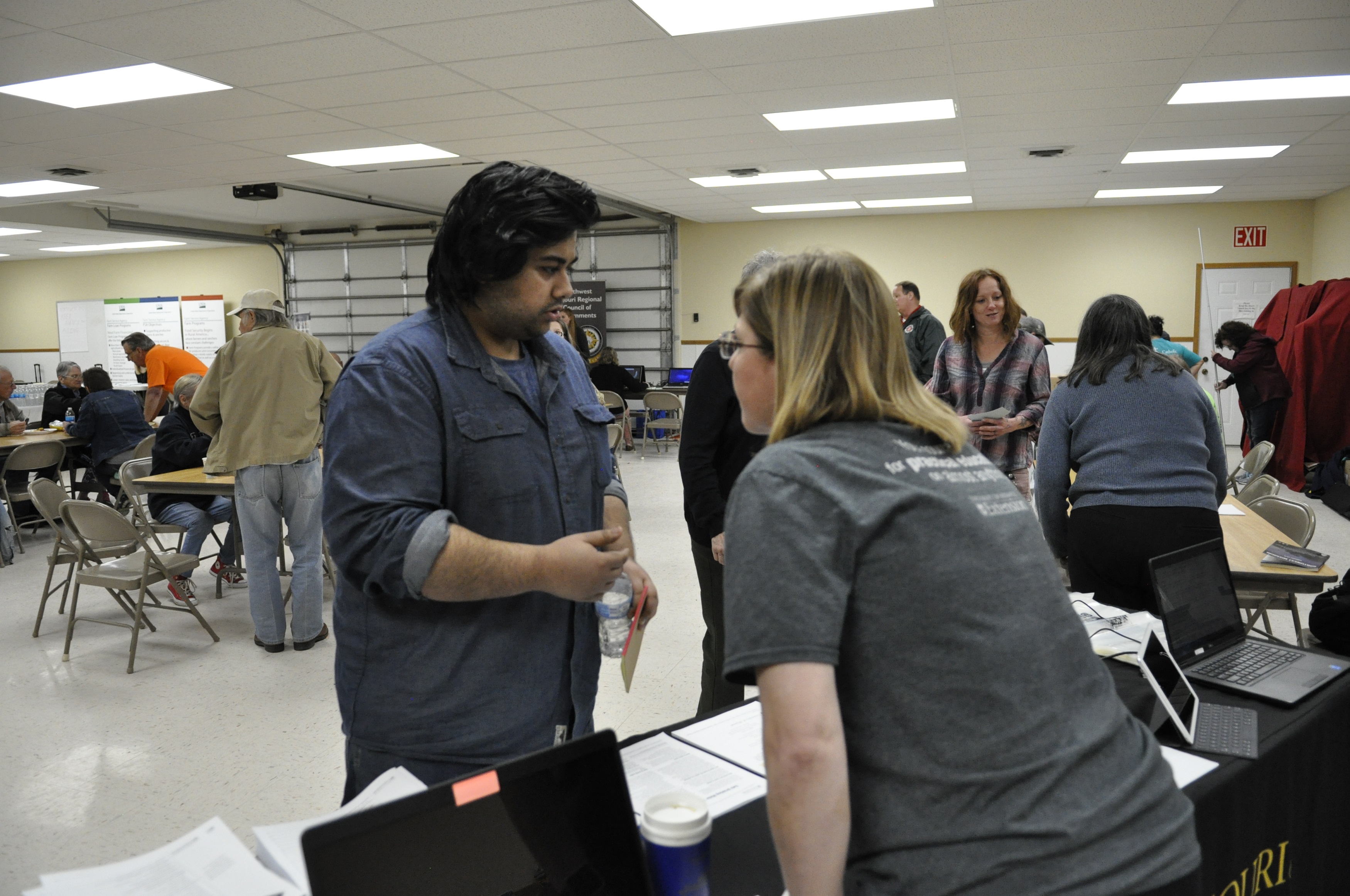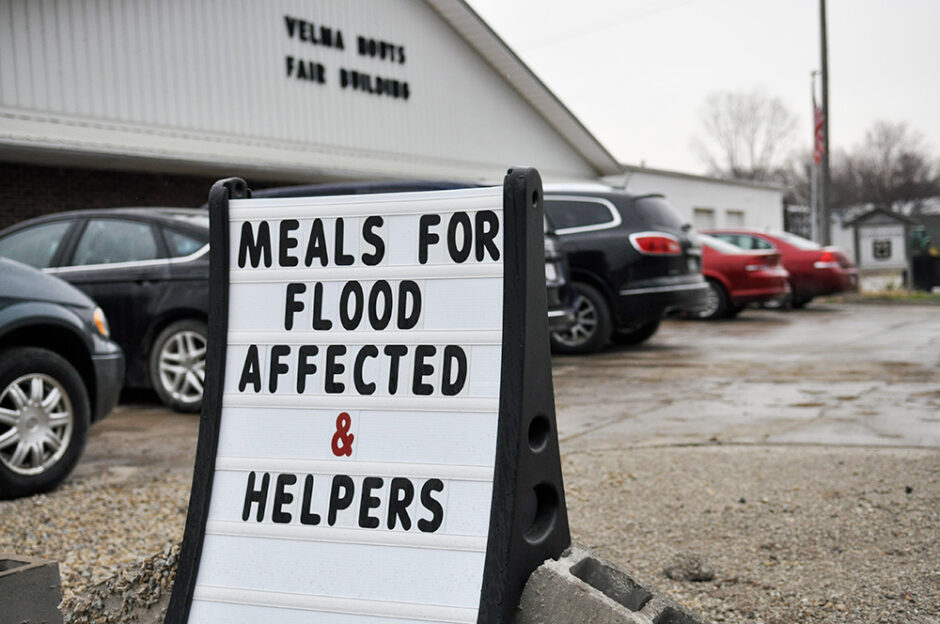April 3, 2019
Dick and Annette Thomas aren’t sure where to begin.
It’s been 26 years since the last time their modest home on Third Street in Craig, Missouri, flooded. This time, the damage is worse, and it happened faster. Within hours of hearing floodwaters from the Missouri River had breached a levee on the edge of town on March 20, Craig’s 222 residents were ordered to evacuate.
Soon after water was rushing across Highway 59 and inundating the town in Holt County, which is located in the northwest corner of the state. The Thomases — Dick, 69, and Annette, 64 — scrambled to save what they could, which, in the end, was precious little from their home of 42 years.
With only hours to spare, Annette rounded up the couple’s four outside cats and the Thomases drove to higher ground. In their wake, more than 3 feet of murky floodwater ravaged their three-bedroom home and dumped soggy corn stalks thigh-high deep in their yard. The couple is temporarily living with Annette’s sister in Shenandoah, Iowa.“I think I saved a chair and a cedar chest and maybe a foot stool,” Annette says. “It all happened so fast.”
“We can’t stay there forever,” Annette says. “The hardest part is the stress and the unknown. What’s going to happen next?”
The Thomases were among more than 200 Holt County families affected by the flood who gathered in late March at the Velma Houts Fair Building in Rock Port, Missouri. Representatives from 18 agencies were there to answer questions and help flood victims with immediate needs such as food, clothing, cleaning supplies and box fans. The event was organized by the county’s long-term recovery committee.
Members of the University of Missouri Extension were there, handing out pamphlets and talking with flood victims about how to clean and repair their homes once the floodwaters recede.
“Flooded roads, leaky basements, property loss and damaged crops are just some of the issues facing these Missourians right now,” says Marshall Stewart, chief engagement officer at University of Missouri System and vice chancellor to extension and engagement at MU. “Additionally, scammers try to profit off of others’ misfortunes, adding insult to injury. The UM System is committed to helping communities prepare and respond to natural disaster.”
Gina Lucas, who works for MU Extension in Andrew and Buchanan counties, says participating in events like the one in Rock Port is important because it reminds flood victims that the university has resources to help.

Gina Lucas, county engagement specialist in Andrew County, visits with a man affected by recent flooding in northwest Missouri about clean up options.
“A lot of this is preliminary,” she says. “A lot of the help these people will need will come later, when the floodwaters go down. But we are letting them know that we know they need help, and we are here for them.”
Lucas is also concerned about the mental health of residents affected by the flood.
“It’s hard to imagine the stress,” she says. “Imagine a farmer whose family has been farming here for generations and has 100 years of genetics wrapped up in cattle that are now stranded in 18 inches of floodwater with no way out?
“Most of all, we want these people to know, ‘We see you,’ ” Lucas says. “So many people feel like no one is noticing.”

More than 200 Holt County families gathered at the Velma Houts Fair Building in Rock Port, Missouri, to seek help with flood-related matters.
Misty Hayworth is grateful for the support. She and her husband, Terry, own two homes — one in Craig and the other in nearby Big Lake — and both flooded. However, only one house was covered by flood insurance.
“We couldn’t afford both,” she says.
Being prepared
MU Extension’s Community Emergency Management Program provides educational and technical assistance to individuals and families, local governments, schools and organizations during and after disasters.
Often, emergency preparedness and personal safety begin with the individual. MU Extension offers several tips when dealing with a flood, including:
- Be prepared with an evacuation plan. If you are told to evacuate, have options available.
- When flooding is imminent, move to higher ground and away from rivers, streams, creeks and storm drains.
- Check your sump pump, and plug basement floor drains.
- Shut off all utilities — electricity, gas, water and phone — if flooding is imminent.
- Move valuables and hazardous materials to higher locations.
- Have a disaster supply kit with first-aid supplies, at least three gallons of water per person, food, battery-powered radio, flashlights and extra batteries.
- Never drive through moving water. Even 18 inches of water is enough to cause a car to float and get swept away.
- Keep the car fueled. Gas stations might not be able to operate.
Visit MU Extension for more information and additional resources on how to deal with flooding.
The couple is staying temporarily in an area motel.
“We were at the house in Big Lake when we heard the levees were breaking,” Hayworth says. “We packed up and got a place at a local motel. Then we heard water was cresting the levee outside Craig. But by the time we got to that house, it was too late.”
Hayworth’s possessions were already washed away from outside the house, her garbage can and mailbox snagged in a nearby ditch. The couple’s Jet Ski was toppled over on the side of the road.
Joe Lear, northwest regional director at MU Extension, says more than 74,000 acres in Holt and Atchison counties have flooded. So far, no crops in the area have been planted and in some cases, none will be planted this year.
“You have to keep in mind that flood season isn’t over until June or July,” Lear says.
Parked on patches of high ground all across Holt County are convoys of tractors, combines, grain carts, augers and tillage equipment that farmers hurriedly pulled from their fields as floodwaters nipped at their heels. In some rural areas, roadways disappear into floodwaters that reach across the horizon as far as the eye can see. In the distance, tops of grain bins, bare trees and out-buildings poke out like heads of curious aquatic creatures. When the wind blows, the floodwater ripples and swirls and sounds like the sea.
Wayne Flanary, a field specialist in agronomy with MU Extension, understands how important it is for him and his co-workers to be present at times of a disaster such as a flood. For now, the people in Holt County will have to wait for the federal and state emergency workers to estimate the damage to their property. But in the meantime, Flannery and other MU Extension workers can provide them information and support.
“Extension work is hard to describe,” Flannery says. “It’s about relationships. The people have to feel like you are credible and knowledgeable.”
In Craig, much of the floodwaters have receded exposing an ugly aftermath of mud and debris. Clumps of wet corn stalks, dirt and loose rocks litter the wet roadways. Lining the ditches are the battered remnants of a former life: bent bicycles; wheelbarrows; tires; a twisted trampoline; and an upside down, pink battery-operated children’s jeep. Houses sag. Trees droop. A rabbit hops through the remains.
When the Thomas’ house flooded in 1993, Annette couldn’t imagine a worse fate. A year later, her oldest son died in a car accident, and life and loss took on new meaning. Today, the couple is searching for a camper to live in while they repair their damaged home.
“I’ve learned how to keep things in perspective,” she says. “Life is more important than possessions.”

A propane tank and masses of corn stalks join the debris left at the side of the road after flood waters receded. MU Extension’s Community Emergency Management Program provides educational and technical assistance to individuals and families, local governments, schools and organizations during and after disasters.




